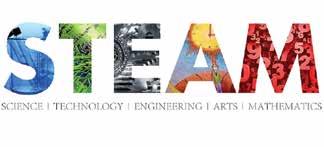
2 minute read
An introduction to steam.........................................................26
The innovators ,educators, leaders, and learners of the 21st century will be intensely required to take thoughtful risks, engage in experiential learning, persist in problem-solving, embrace collaboration, and work through the Creative process. However to.prepare young Africa for the 21st century challenges there is a vital need for the introduction os STEAM
The introduction of STEAM is a grand opening to an educative environment that is fluid, dynamic and relevant.
Advertisement
Its a disprution of the everyday classroom learning whose philosophy is theory based rather than practical based. This both leads to student achievement and teacher efficacy. where the student excels at cognitive development, increase literacy and math skills, and help students reflect meaningfullly on their work and that of their of their peers. The arts in the STEAM approach of education helps students to improve their language and further outperform their counterparts , who received no arts integration, in both math and language. STEAM as an educative appraoach was designed to meet the needs of a 21st century economy. STEAM allows students to connect their learning in these critical areas together with arts practices, elements, design principles and standards to provide the whole pallet of learning at their disposal. STEAM removes limitations and replaces them.with wonder, critique, inquiry, and innovation.
The intention of STEAM is to select an essential question and problem. While the implemention of STEAM is how to answer a selected question and find a solution to a selected problem. In greater details, STEAM looks at the elements that are contributing to a certain problem/question. lead to a certain problem and why it exists. The learner begins to unearth alot of key background information, skills, or processes that students already have to solve a problem and a specific problem. Another critical component in STEAM is about active research and intentional teaching that leads to discovery. And in this every student researches problems to find possible solutions and perhaps present those solutions to critical issues.
As well as what is not working as per current existing solutions.
This allows students to discover gaps in pre-existing solutions and apply their innate skills to given processes in solving a problem more effectively. After the students discover and carefully analyze current solutions as well as what still needs to be addressed, they can begin to create their own solution or composition to the problem.
Finally, this is where they use their skills, processes and knowledge that were taught in the discoverage stage and put everything they learnt to work. The moment after students learn to create their own composition and solution to specific problems then it vital for there to be a presentation. The presentation helps in constructive feedback and criticism.
Based on the student‘s perspective surrounding the problem at hand. The feedback helps students to learn how to give and recieve input. Plus the revision of their work basing on given feedback inorder to be able to produce better solutions.
There are three fundamentals of STEAM namely :critical thinking, inquiry and process-based learning. STEAM should be able to invoke questions, deep questions that google wont answer. STEAM should provoke inquiry, curiosity, and stimulate the ability to find solutions to a specific problem, and being creative in the finding of solutions is at the heart of STEAM.
Essentially STEAM is built upon the principle of asking really good questions and then seeking solutions to the problems that are out there.










